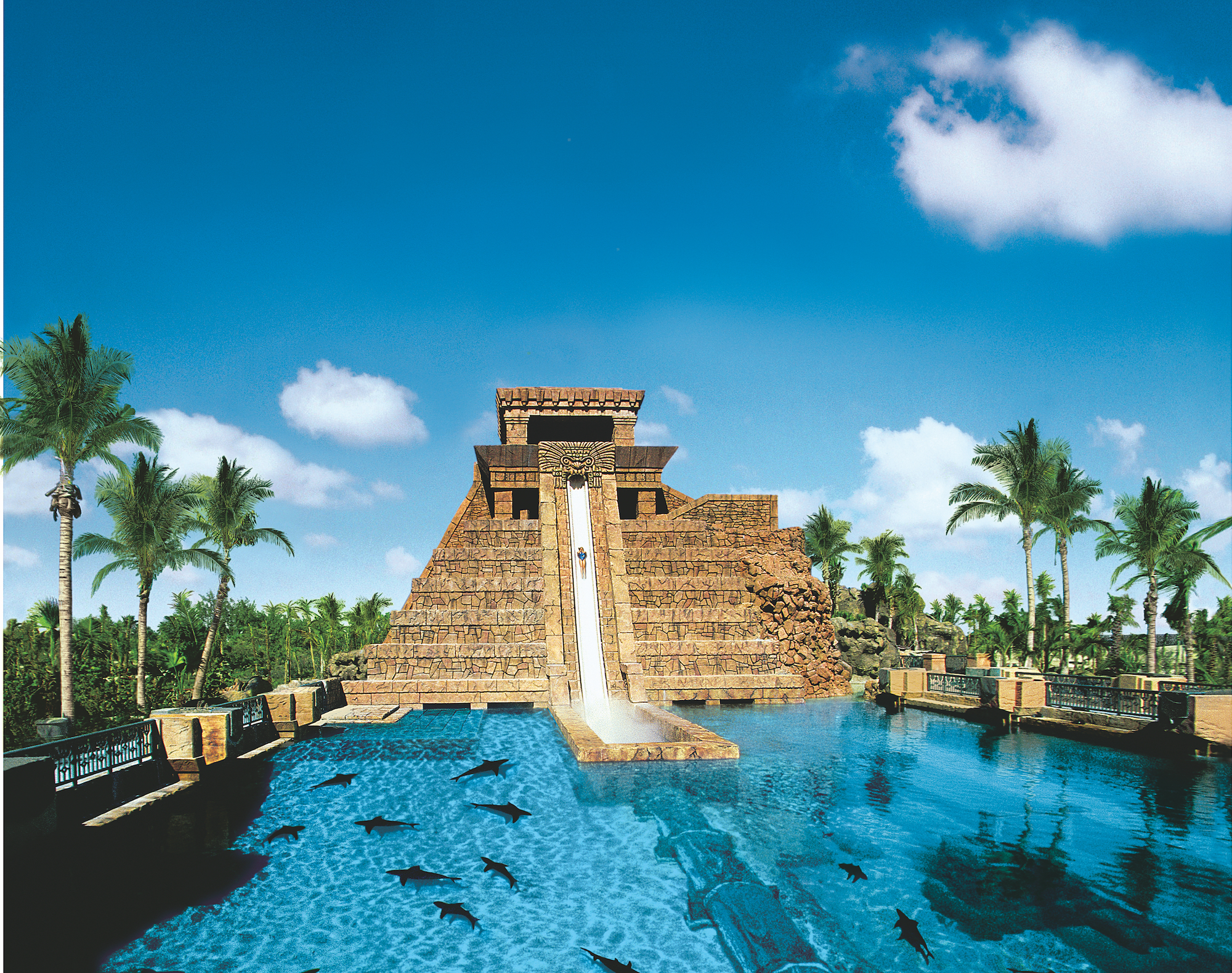
Standing in a clear, underwater acrylic tunnel, I watched any number of aquatic life forms going about their business all around me, totally oblivious to my intrusion. I was one with the fish; we shared a fish-eyed view of the coral-colored Atlantis Royal Towers Resort which, from our perspective, appeared as a towering, shimmering reflection in the water.
Such was my introduction to the fascinating multi-level marine adventure integral to the $800 million Atlantis, Paradise Island Resort on Paradise Island, Bahamas.
Of course, the term “resort” doesn’t begin to describe this one-of-a kind experience. Centered around an archaeological dig recreating the alleged 11,000-year-old Lost Continent of Atlantis, the expansive wonderland includes 3414 rooms, 11 pools, a five-story Mayan Temple with 18 unusual waterslides and rides, almost 40 restaurants, a 100,000-square-foot entertainment center with the largest casino in the Caribbean, as well as the largest outdoor marine animal habitat in the world, which covers the entire grounds.
Beyond the fountains of unusual fun, fish and frolic that routinely mesmerize guests is the revolution in marine research and management that is unfolding daily behind the scenes. That’s the part that most excites me.
Directors of other aquariums and marine experts from around the country consistently come to observe and learn. Michelle Liu-Williamson, fish curator and director of all water features — and self-proclaimed head of “everything filled with water, except bath tubs and toilets” — observes: “They are amazed at what we’ve accomplished here, and there is no better feedback than to receive such accolades from your peers.”
The centerpiece of this mammoth memorial to the Atlantis Civilization is the Waterscape around which it all revolves. Eleven million gallons of filtered seawater flowing from the ocean reinvents itself in a multitude of forms: Waterfalls, lagoons, swimming pools, water slides, river pools and more, covering an area of 141 acres. Most impressive are the 14 lagoons that cater to the 50,000 current marine inhabitants representing more than 250 species.
There are almost as many ways to view them as there are fish. Underground viewing tunnels, from the balcony off your room, in underwater exhibits, through restaurant water-walls as you dine, from within see-through acrylic tunnels while descending a water slide, from a 100-foot suspension bridge — and, oh yes, as you stroll along the many walkways and viewing stations located all around the grounds.
The underwater tunnel walls of “The Dig,” with its rambling maze of passageways, alleyways and corridors, are lined with large picture-window views of deep-water environments. This Ruins Lagoon, home to life-like remains of a whole city and very-much-alive animals, simulates the feeling of being underwater, but without the scuba equipment.
Also at The Dig are smaller habitats of rare animals living in separate water panels among their own kind, some of which never have successfully flourished in captivity. These captivating exhibits introduce you to venomous Lion Fish, equally unfriendly piranhas, pernicious moray eels, sad-looking Look Downs, elusive Amazon Gars, florescent coral and phosphorescent jellyfish.
Nearby, less menacing lobsters cluster together in the dark, crawling along nets, metal grates and each other, along the window panels as well as overhead. Each species thrives in its own environment, which the lobster tanks at restaurants certainly aren’t.
 So, too, in the massive Predator’s Lagoon outside. Yes, this is a man-made lagoon with man-made waterfalls and imported greenery, but the jewfish, yellow-fin tunas, mahi-mahi, sting rays and sharks swimming by in front of you are real. You do not for one minute confuse this with Sea World.
So, too, in the massive Predator’s Lagoon outside. Yes, this is a man-made lagoon with man-made waterfalls and imported greenery, but the jewfish, yellow-fin tunas, mahi-mahi, sting rays and sharks swimming by in front of you are real. You do not for one minute confuse this with Sea World.
As testimony to how well-fed and cared-for the marine populace is, the Predator Lagoon is what it says: a place where lots of sharks and barracuda swim freely among a variety of fish that ordinarily might be their dinner. With the natural habitat mandate always in force, the deep-water caves and grottoes of the lagoon provide just the sort of living arrangements that appeal to these cohabitants.
The shallow, grassy flats of the Water’s Edge Lagoon, however, appeal to bonefish, cownose rays and baby sharks, and the Sting Ray Lagoon is private real estate for…well, sting rays. Should these close-up observations inspire you to mingle further, there’s a seven-acre snorkeling lagoon stocked with tropical fish. On the other hand, just walking around, over and underneath the resort kinda makes snorkeling redundant.
That’s what the tourist sees – indeed, not your usual resort fare. What most visitors don’t see are the advancements in preservation and protection of the surrounding eco-system that is the real focus of the six marine biologist experts and over 60 marine technicians on site. This is serious stuff.Several years ago, three baby black-nosed sharks — a little-understood and under-studied species — were born in the Predator’s Lagoon, the first of this species ever to be born in a “controlled environment.” Several Caribbean reef-shark mamas followed suit. According to Lui-Williamson, “The birth of these young sharks provides the invaluable opportunity to learn more about their life cycle, growth and feeding habits.” By the way, mothers and pups are doing fine.
Dr. Robert Heuter, director of the Center for Shark Research at Mote Marine Laboratory in Sarasota, Florida heralded the births as testimony to the quality of the marine habitat at Atlantis. “Normally, it’s hard to get (sharks) to even feed and be maintained for long periods of time. For them to actually mate and give birth means that they’re actually very happy and doing quite well,” he claims.
Not so for the tiger shark, whose solo status tends to mitigate against reproduction. But it’s making history on his own, as the only one of its kind ever to successfully survive – no, more than that, thrive – in an aquarium environment. According to Liu-Williamson, this first-hand exposure to the animal debunks myths and defies reputation. Long regarded as a blood-thirsty, waiting-to-rip-you-to-pieces kind of guy, Liu-Williamson says the tiger shark has been unfairly maligned for years.
The raising of jellyfish has been another major challenge at aquariums for many years. At Atlantis, it’s yet another successful “first,” one that has been studied by aquarium experts from around the country. Because preservation of endangered species is such a top priority, it’s also not surprising to find that a special home has been created to breed endangered Green Sea Turtles, many of whose young are unable to find their way back to the water once hatched.Liu-Williamson touts Atlantis’ marine habitats as the finest facility in the world in terms of numbers of animals, their size, the habitat’s size and the quality of the staff. She attributes its success in part to the nature of the water flowing in from the ocean and the emphasis on creating natural habitats.
Apparently, though, there’s another secret ingredient. All the animals feast upon the same seafood that is served in the hotel’s outstanding restaurants. Lucky, lucky fish! For more information, visit AtlantisBahamas.com or call 1-800/ATLANTIS.
About the Author:
Fyllis Hockman, a frequent contributor to FAB Senior Travel, lives in the Washington D.C. area. She is an established, award-winning travel writer and a member of Society of American Travel Writers member since 1992. She has been traveling and writing for almost 30 years.

![Predator_Tunnel_49456_high[1]](https://18.189.245.79/wp-content/uploads/2016/01/Predator_Tunnel_49456_high1-679x1024.jpg)


![Navigation_Room,_The_Dig_66_high[1]](https://18.189.245.79/wp-content/uploads/2016/01/Navigation_Room_The_Dig_66_high1.jpg)
![Seagrapes_Viewing_Window___69_high[1]](https://18.189.245.79/wp-content/uploads/2016/01/Seagrapes_Viewing_Window___69_high1.jpg)



